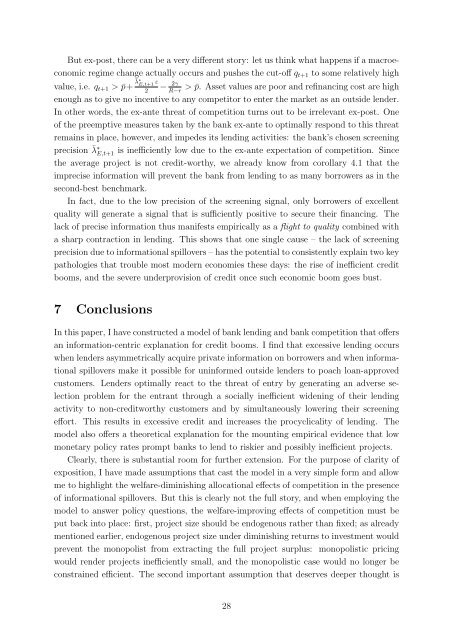Bank Competition, Information Choice and Inefficient Lending Booms
Bank Competition, Information Choice and Inefficient Lending Booms
Bank Competition, Information Choice and Inefficient Lending Booms
Create successful ePaper yourself
Turn your PDF publications into a flip-book with our unique Google optimized e-Paper software.
But ex-post, there can be a very different story: let us think what happens if a macroeconomic<br />
regime change actually occurs <strong>and</strong> pushes the cut-off q t+1 to some relatively high<br />
value, i.e. q t+1 > ¯p+ ¯λ ∗ E,t+1 ε<br />
2<br />
− 2γ<br />
R−r<br />
> ¯p. Asset values are poor <strong>and</strong> refinancing cost are high<br />
enough as to give no incentive to any competitor to enter the market as an outside lender.<br />
In other words, the ex-ante threat of competition turns out to be irrelevant ex-post. One<br />
of the preemptive measures taken by the bank ex-ante to optimally respond to this threat<br />
remains in place, however, <strong>and</strong> impedes its lending activities: the bank’s chosen screening<br />
precision ¯λ ∗ E,t+1 is inefficiently low due to the ex-ante expectation of competition. Since<br />
the average project is not credit-worthy, we already know from corollary 4.1 that the<br />
imprecise information will prevent the bank from lending to as many borrowers as in the<br />
second-best benchmark.<br />
In fact, due to the low precision of the screening signal, only borrowers of excellent<br />
quality will generate a signal that is sufficiently positive to secure their financing. The<br />
lack of precise information thus manifests empirically as a flight to quality combined with<br />
a sharp contraction in lending. This shows that one single cause – the lack of screening<br />
precision due to informational spillovers – has the potential to consistently explain two key<br />
pathologies that trouble most modern economies these days: the rise of inefficient credit<br />
booms, <strong>and</strong> the severe underprovision of credit once such economic boom goes bust.<br />
7 Conclusions<br />
In this paper, I have constructed a model of bank lending <strong>and</strong> bank competition that offers<br />
an information-centric explanation for credit booms. I find that excessive lending occurs<br />
when lenders asymmetrically acquire private information on borrowers <strong>and</strong> when informational<br />
spillovers make it possible for uninformed outside lenders to poach loan-approved<br />
customers. Lenders optimally react to the threat of entry by generating an adverse selection<br />
problem for the entrant through a socially inefficient widening of their lending<br />
activity to non-creditworthy customers <strong>and</strong> by simultaneously lowering their screening<br />
effort. This results in excessive credit <strong>and</strong> increases the procyclicality of lending. The<br />
model also offers a theoretical explanation for the mounting empirical evidence that low<br />
monetary policy rates prompt banks to lend to riskier <strong>and</strong> possibly inefficient projects.<br />
Clearly, there is substantial room for further extension. For the purpose of clarity of<br />
exposition, I have made assumptions that cast the model in a very simple form <strong>and</strong> allow<br />
me to highlight the welfare-diminishing allocational effects of competition in the presence<br />
of informational spillovers. But this is clearly not the full story, <strong>and</strong> when employing the<br />
model to answer policy questions, the welfare-improving effects of competition must be<br />
put back into place: first, project size should be endogenous rather than fixed; as already<br />
mentioned earlier, endogenous project size under diminishing returns to investment would<br />
prevent the monopolist from extracting the full project surplus: monopolistic pricing<br />
would render projects inefficiently small, <strong>and</strong> the monopolistic case would no longer be<br />
constrained efficient. The second important assumption that deserves deeper thought is<br />
28
















